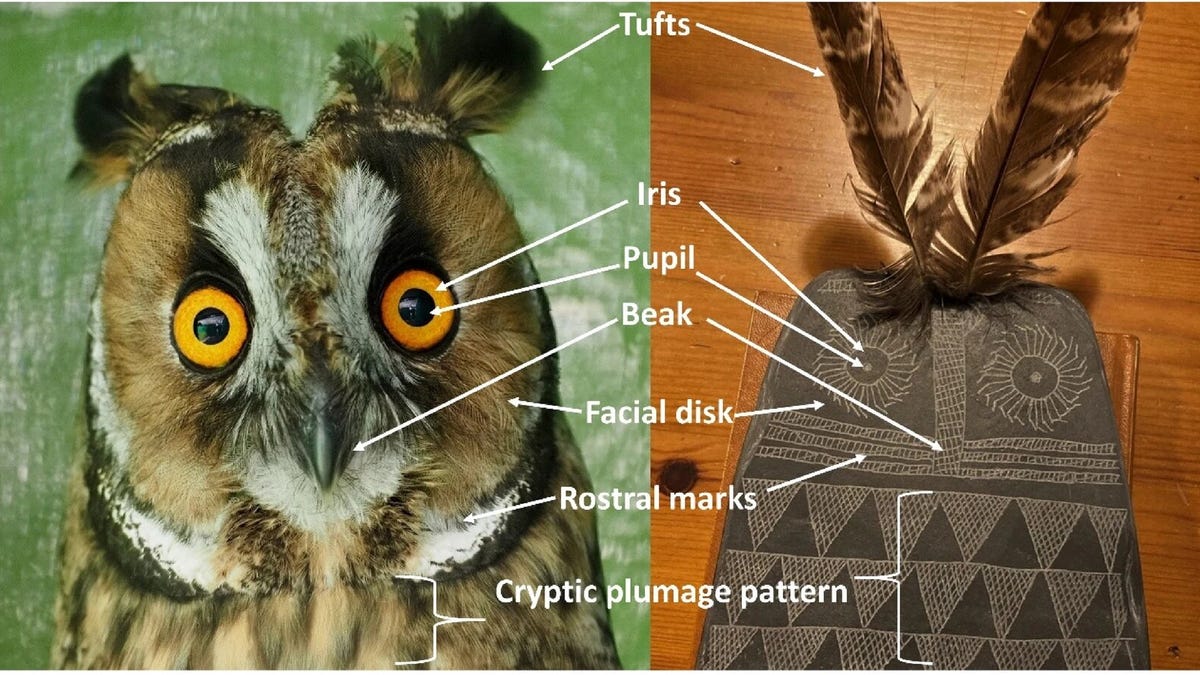5,000-Year-Old Owl Plaques May Have Been Kids Toys, Not Religious Icons
New evidence suggests that, for decades, archeologists have been mistaking ancient knickknacks for idols of goddesses.

On the right is one of the owl plaques picked up by scientists on the Iberian peninsula. On the left, of course, a real-life owl.
Since the late 19th century, archeologists have stumbled on oodles of miniature owl-shaped plaques across the Iberian Peninsula, nestled into tombs, pits and crevices. But for decades, no one's been able to fully agree on what these little slate treasures might have once represented.
Some have said they were religious artifacts, perhaps serving a symbolic purpose for their creators. Others have suspected they were idols of goddesses, prayed to in times of distress. And still others have argued that these owl replicas weren't mystical objects at all but rather made in honor of the dead. But a crew of archaeologists published paper Thursday in the journal Scientific Reports with the most adorable guess yet.
Maybe these owl plaques were just cute kiddie toys.
After analyzing 100 plaques dating back 5,000 years, which falls during the Copper Age, and rating them based on how owl-y their traits were -- categories like featheriness, color patterns, beaks, and so on -- the team realized the ancient relics looked awfully similar to 100 modern images of owls drawn by children between the ages of 4 and 13.
"Owl engravings could have been executed by youngsters, as they resemble owls painted today by elementary school students," the study authors write. "This also suggests that schematic drawings are universal and timeless."
Some of the owl drawings from modern times that the researchers used for comparison.
Fascinatingly, the team also recognized how the "owliness" of modern kids' drawings naturally got better as the person doing the drawing got older, which "may help explain at least partially why there are so many plaque types, and why some are more evocative of owls than others," the researchers write in their paper.
Many of the plaques, according to the study, even had two perforations at the top, which the authors believe could've been where actual owl feathers were inserted for ultimate resemblance.
"If stone toys were made at the end of the stone age, metal tools in subsequent periods surely made easier the carving of wood figurines, which would hardly leave any traces in the archaeological records," the authors write. "Similarly, skin or textile pieces would disintegrate quite rapidly. Therefore, owl-like objects made in stone provide perhaps one of the few glimpses to childhood behavior in the archaeological record of ancient European societies."
Various owl plaques may've denoted different species. A couple of examples.
Humans just want to have fun
In thinking of how kids might've actually played with their owl toys, the researchers suggest the owls could've been pieces in a larger game, sort of like the shoe, car and thimble in Monopoly, except each child might've had a unique plaque.
That uniqueness might explain why some of the models were found in tombs. Children who died might've been buried alongside their little inanimate friend, or at the very least, grown-ups might've seen the figures as important enough to use in burial rituals for sentimental reasons. That would make it more understandable why something made of slate -- a superabundant material at the time -- would be used for funeral practices where opulent gems and gold typically made the grade.
Various owl relics dating back thousands of years. In total, scientists estimate 4,000 of these relics have been located to date.
"The way slates exfoliate makes [it] easy to craft owl-looking plaques," the authors write. "Plaque manufacture and design were simple and did not demand high skills nor intensive labor as demonstrated in replication experiments."
Another hypothesis is that the owl relics could've been characterized as dolls. Some of the plaques appeared to be painted and dressed with textiles.
"It cannot be discarded that some 'idols' were in fact objects with just a recreational value, literally dolls that may have entertained both their makers and younger members of the community in playful activities or as learning activities," the paper says.
The team's undeniably heartwarming concept is bolstered by the idea that even objects that had religious value could've possessed some fun purposes as well, thousands of years ago. In that sense, the scientists also believe it's possible most everyone with a theory about these owl figures might kind of be right -- the decorations could've served a dual, maybe even triple, purpose. Centuries ago, the boundary between art, ritual and play may've been quite blurred.
And finally, in terms of why kids played with owl toys rather than dog, cat, or maybe bat ones -- dogs and cats being particularly famous for their kinship with humans -- the authors say that could be due to the bird's special relationship with people during the Copper Age and beyond.
First of all, many owl species tend to live really close to people, and second, it's very possible that societies viewed owls as helpers, because they'd clear mice and other pesky creatures from areas where farming would go on.
"Our hypothesis that the slate plaques of the Iberian Peninsula in the Chalcolithic were toys inspired on owls which may have had, at least originally, a recreational use, is based on the transcultural fascination of humans by owls since time immemorial," the authors write.
"Additionally, applying Ockham's Razor, our hypothesis is simpler than the alternative of resorting to a complex symbolic world with fertility goddesses represented by idols or heraldic mnemonic devices ... of which there are no proofs anyway."

